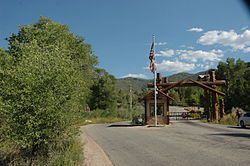Demographics
Historical population| Census | Pop. | Note | %± |
|---|
| 2000 | 289 | | — |
|---|
| 2010 | 607 | | 110.0% |
|---|
| 2020 | 866 | | 42.7% |
|---|
As of the census [3] of 2000, there were 289 people, 108 households, and 81 families residing in the CDP. The population density was 107.2 people per square mile (41.4/km2). There were 485 housing units at an average density of 179.8/sq mi (69.4/km2). The racial makeup of the CDP was 97.92% White, 1.04% African American, 0.69% Native American and 0.35% Asian. Hispanic or Latino of any race were 4.50% of the population.
There were 108 households, out of which 33.3% had children under the age of 18 living with them, 71.3% were married couples living together, 2.8% had a female householder with no husband present, and 24.1% were non-families. 14.8% of all households were made up of individuals, and 0.9% had someone living alone who was 65 years of age or older. The average household size was 2.68 and the average family size was 3.06.
In the CDP, the population was spread out, with 27.7% under the age of 18, 3.8% from 18 to 24, 40.1% from 25 to 44, 23.5% from 45 to 64, and 4.8% who were 65 years of age or older. The median age was 34 years. For every 100 females, there were 118.9 males. For every 100 females age 18 and over, there were 117.7 males.
The median income for a household in the CDP was $55,208, and the median income for a family was $60,395. Males had a median income of $44,286 versus $30,625 for females. The per capita income for the CDP was $22,214. None of the families and 3.0% of the population were living below the poverty line, including no under eighteens and 42.9% of those over 64.
This page is based on this
Wikipedia article Text is available under the
CC BY-SA 4.0 license; additional terms may apply.
Images, videos and audio are available under their respective licenses.


